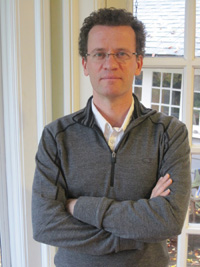It took seven years for Yann Martel to write his most recent book, Beatrice and Virgil: A Novel (Spiegel & Grau, 2010). The story began as a two-act play that served as an allegory to the Holocaust, from which he took fragments to use in his novel. It eventually evolved from the interplay between the two animals for which the book is named into a story featuring a mysterious taxidermist — because taxidermists attempt to give the appearance of “life” to deceased animals — and a character named Henry.
On tour promoting his latest book, Martel, whose bestselling Life of Pi earned him the 2002 Man Booker Prize for Fiction, shared Beatrice and Virgil at an intimate writer’s salon last month in support of the upcoming 26th Annual Cherie Smith Jewish Community Centre of Greater Vancouver Jewish Book Festival — taking place Nov. 20-25 — and The Vancouver Holocaust Education Center.
Martel went into extensive detail about his process of writing the book, defending the use of fiction as a lasting and moving testimony to relating the horrors of the Holocaust.
Playing on positive Jewish stereotypes, Martel explained that Henry represents Jewish life in Germany. He plays the clarinet, considered a “very Jewish instrument” because of its use in Klezmer music. He also drew upon a 125-page essay he wrote on representations of the Holocaust that feature at the beginning of the book.
Beatrice and Virgil is a story about a writer who meets a taxidermist and together, in a sense, they meet the Holocaust. Martel deals with the Holocaust in a non-literal and non-historical fashion, compared to other books that express the tragedy, like Anne Frank, among so many others.
Just as in Life of Pi, Martel features animals as metaphors. In Beatrice and Virgil, a story far darker in tone and storyline, the significant difference is Martel’s application of his metaphors to the Holocaust, in this case, two stuffed animals — Beatrice, a donkey, and Virgil, a monkey. According to Martel, the main characters are named in reference to Dante’s Divine Comedy, an allegory on 14th-century Italy, in which Virgil and Beatrice served as guides to help Dante find his way back from moral confusion by travelling through hell, purgatory, and heaven.
For Martel, animals operate outside of a moral framework, which inspires sympathy. Since animals have the effect of drawing people in, he anthropomorphized the animals in the play within the novel, and signal Martel’s allegorical intentions.
Martel explained how he used the literary technique of animal allegory to signal to readers that the book was not a historical analysis, but a fictional method of relating the true horrors of the Holocaust.
“I’m not Jewish and I’m not European,” Martel says, though he spent his formative years attending a British school in France. “My link to the Holocaust is as a complete outsider.”
A descendant of a Canadian family rooted in Quebec, his parents briefly moved to Spain, where he was born.
“I have no personal experience, no familial experience, no genetic experience at all with the great tragedy [of the Holocaust], the greatest tragedy of the 20th century,” he says.
Yet Martel says he has been profoundly affected by the Holocaust and the suffering of the Jewish people.
While a child studying history in school, he found the study of war to be comprehensible, whereas to him the Holocaust was not. Though war is violent and tragic, “the idea of having an enemy whom you must fight makes sense,” suggests Martel. However, the dynamics of the Holocaust — equally as violent as war — did not make sense to him.
“In war you have an enemy and you go to war against your enemy,” Martel says. “The Holocaust seemed to be, you take your friend and you shoot him.”
The Jews of Europe were fully integrated in society, contributing greatly to each society in which they lived. So why were Jews suddenly targeted by the Nazis for murder? Martel could not come to terms with this historical fact compared to the dynamics of war, which he feels is much more easily understood by children.
The Holocaust, relates Martel, “stayed in my memory as a historical oddity.” Later, Martel studied the Holocaust in greater depth, first reading historical works and then literature, watched Hollywood films and European documentaries, and, as an adult, visited Auschwitz and Yad Vashem. He did all of this because, he says, the Holocaust “always startled me and horrified me.” Eventually, after the success of The Life of Pi, he decided he wanted to write about the Holocaust, but in his own way — through the lens of fiction.
Martel admits that Holocaust survivors will likely hate his use of metaphor and allegory, but he maintains the technique is needed by those who did not experience the Holocaust themselves.
In writing his work of fiction, Martel insists the Holocaust needs to be seen through art as well as history because, in his view, works of art last longer than works of history, and there is a timelessness to art and fiction absent in non-fiction.
When challenged about the relevance of fiction if readers lack understanding of the actual events, Martel conceded that knowledge of history is a prerequisite to reading such fictional works as Beatrice and Virgil.
Like Orwell’s Animal Farm being an allegory of Stalin’s Russia, Martel uses animals to describe Hitler’s horrors perpetrated against the Jews. But in a book on the Holocaust, the reader essentially knows the tragic conclusion. Art is an interpretation, but one must first know the history.
If one wants to know about Russian history, suggests Martel, one should not start by reading Orwell’s Animal Farm. Teach history, then literature.
Arthur Wolak is a freelance writer in Vancouver. A version of this article first appeared in the Jerusalem Post.
